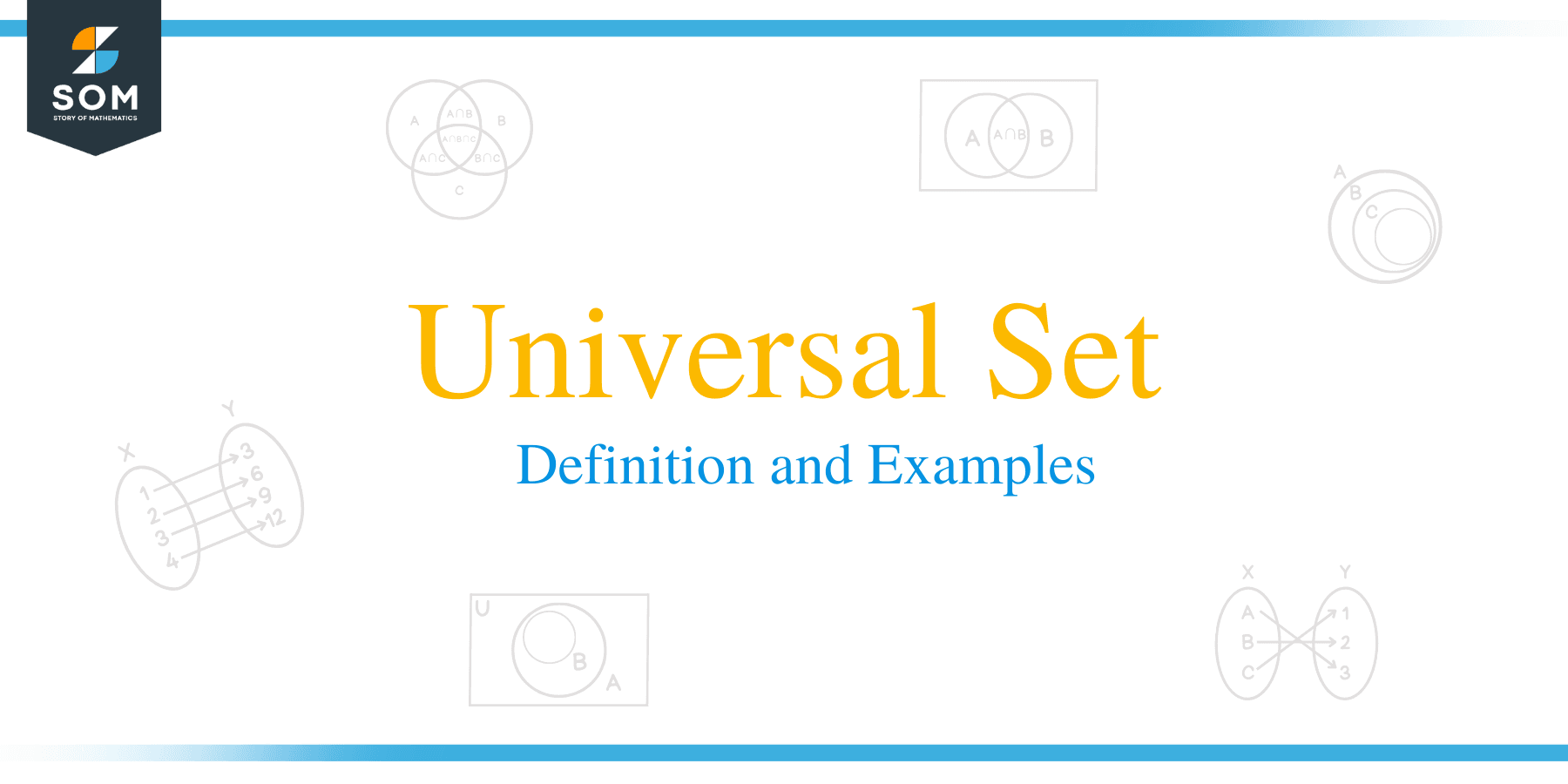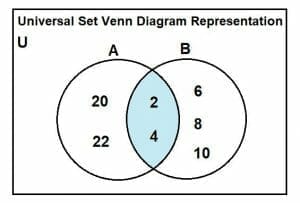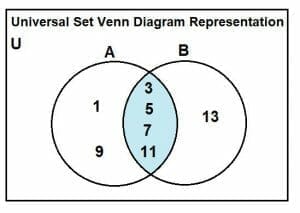- Home
- >
- Universal set – Definition and Examples
JUMP TO TOPIC
Universal Set – Definition and Examples
 In previous lessons, we learned that a set is a collection of objects and that it is possible to use Venn diagrams to explain both set relationships and logical relationships. We also learned about various types of sets. In Mathematics, all these different types of sets have their value. But the set that is known to build the foundation of any two or more sets is the Universal Set.
In previous lessons, we learned that a set is a collection of objects and that it is possible to use Venn diagrams to explain both set relationships and logical relationships. We also learned about various types of sets. In Mathematics, all these different types of sets have their value. But the set that is known to build the foundation of any two or more sets is the Universal Set.
In this article, we will be developing an understanding of the Universal Set.
A universal set (usually denoted by U) is a set that has elements of all the related sets without any repetition of elements.
We will cover the following topics in this article:
- What is a universal set?
- How to represent the universal set?
- Difference Between Universal Set and Union of Set.
- Examples
- Practice Problems
What is a Universal Set?
The universal set is the reflection of its name. A universal set, in general terms, is defined as the set of all objects under consideration. A universal set is a set that contains all the elements or objects of other sets, including its elements. It is typically denoted by “U.”
The exact definition of U is based on the context or theory being considered. The elements contained in U may vary according to the context of sets being stated. For instance, we might describe U as the collection of all living things on planet earth. In this case, the set of all the mammals, set of all the reptiles, and set of all the birds become a subset of U. Similarly, we can say that set of all countries in the world is universal.
In mathematical terms, the universal set is the set of whole numbers. Depending on the context, this set may also be the set of all the shapes, a set of all the second-degree polynomials, and many more.
Since a set is a collection of various entities with a common property, the universal set is the collection of all the elements relevant to a specific subject. It could be anything like real numbers, a deck of cards, the world’s inhabitants, etc. Elements in a universal set are not repeated elements, so all these elements are distinct and unique.
Let’s solve an example to develop a firm understanding of universal sets.
Example 1
Consider, there are three sets, namely X, Y, and Z. The elements of each set are given below:
X={2, 4, 6, 8}
Y={3, 7, 9, 11}
Z={4, 8, 11}
Find the universal set for all three sets X, Y, and Z.
Solution
We know that the universal set contains all the elements of the given sets; thus, the universal set of X, Y, and Z is given by:
U={2, 3, 4, 6, 7, 8, 9, 11}
We can see from the solution above that the elements of sets X, Y, and Z are completely available in the Universal set ‘U’. Also, there are no elements repeated in the universal set, and all the elements are unique.
How to Represent a Universal Set?
Now that we know what a universal set is, the next topic addresses its representation. Generally, the universal set is represented by the capital letter “U.” Their representation is the same as any other set. All the elements of the universal set are enclosed in the ‘{}’ curly brackets.
A universal set can be both finite or infinite. If the universal set is infinite, or even if it’s finite with a huge number of elements, then the ellipses, the three dots (…), are used to represent the universal set. An example is shown below:
U = {1, 2, 3, …}
Or,
U = {1, 2, 3, …, 4000}
In mathematical terms, the universal set is a collection of numbers. So we can also use bold capital letters for its representation. There is no specific universal set symbol notation.
Consider a universal set of natural numbers, which is represented by N. The notation of this universal set is somewhat like follows:
N = {1, 2, 3, 4, …}
Some examples of the universal set are given below.
Example 2
Let A is equal to a set of odd numbers, and B is equal to the set of even numbers. What is the universal set of A and B?
Solution
The sets A and B can be written as:
A = {1, 3, 5, 7, 9…}
And,
B = {2, 4, 6, 8, 10…}
So, the universal set is:
U = {1, 2, 3, 4, 5, 6, 7, 8, 9, 10…}
From the above example, we can see that the universal set U of the sets A and B results in the set of natural numbers.
Difference Between Universal Set and Union of Set
Students mostly get confused between the universal set and the union of the set. Some make the common mistake of thinking that the sets are similar. But that is not the case. We can understand this better by analyzing the definitions of these two sets.
The universal set, including its elements, is a set composed of all elements or objects. Whereas the union of sets is a two-set operation, say A and B, resulting in a set with all the elements that belong to both sets A and B.
The following example will help us understand this difference better.
Example 3
Consider three sets with elements U = {3, 5}, set X = {a, s, d}, and set Y = {e, f, g}. Find the universal set U and the union of sets X and Y?
Solution
The universal set of the 3 sets is given as follows:
U = { a, s, d, e, f, g, 3, 5}
Now, let’s find the union. The union between X and Y is given as:
X U Y = {a, s, d, e, h, g}
Thus, the universal set is the combination of X, Y, and U itself, whereas the union of X and Y contains X and Y elements only.
Representation of Universal Set through Venn Diagram
The Venn Diagram represents two or more circles used to illustrate the relationships among different sets of finite objects. Since the set representation is entirely visual, so different shapes are used to depict Venn diagrams.
In the Venn diagram, the circles are used to represent sets. These circles or sets are contained within the universal set, which is represented by a rectangle.
The universal set is represented by a rectangle in the Venn diagram and denoted by U. Let’s consider an example. Suppose a set of multiples of 2 is given as A = {2, 4, 20, 22}. Now consider another set B which is the set of even numbers given as B = {2, 4, 6, 8, 10}. The universal set in this case is the set of numbers U = {1, 2, 3, 4, 5, 6, 7, 8, 9, 10}. The Venn diagrams as follows:

Let’s solve an example to understand this better.
Example 4
Let set A = {1, 3, 5, 7, 9, 11} and set B = {x : x is a primary number and 2<x<17}. Show the relationship between sets A and B where universal set U is U = {set of natural numbers till 20}.
Solution
To solve this example, let’s first simplify the sets.
Set B can be rewritten as:
B = {3, 5, 7, 11, 13}
Similarly, set U can be rewritten as:
U = {1, 2, 3, 4, 5, …, 20}
Their relationship through the Venn diagram is as follows:

Universal Set and its Subsets
Since a universal set is a set with all the elements related to any specified context of sets, all the other sets in it are the Universal set subsets.
Before we deal with the universal set and its subsets, let’s have an overview of subsets. A set A is a subset of B if all A’s elements are also B’s elements. The symbol represents the subset ⊆.
Thus we represent the A as a subset of B as:
X⊆Y
Since all the sets are the subset of themselves, hence, the universal set is also the subset of itself which can be represented as:
U ⊆ U.
Consider the example below to evaluate this concept.
Example 5
Consider three sets U = {0,1, 2, 3, 4, 5…}, X = {1, 3, 5}, and Y = {2, 4, 6}. List the possible subsets.
Solution
It is evident that set X and Y are the subsets of U, so:
X ⊂ U
X is the proper subset of universal set U.
Similarly, for the set Y:
Y ⊂ U
Y is the proper subset of universal set U.
Some other possible subsets obtained from the universal set can be:
O = {1, 3, 5, 7,…} i.e. a set of all odd numbers.
E = {2, 4, 6, 8,…} i.e. a set of all even numbers.
To further strengthen the concept of Venn diagrams, consider the following practice problems.
Practice Problems
- If X = {Asia, Africa, North America}, and Y = {South America, Antarctica, Europe, Australia}, what could be the universal set?
- Given that U = {5, 6, 7, 8, 9, 10, 11, 12}, list the elements of the following sets.
(a) A = {x : x is a factor of 60} (b) B = {x : x is a prime number}
3. If U = {2, 4, 6, 8, 10, 12, 14}, then which of the following are subsets of U.
X = {2, 4}, Y = {0}, Z = {1, 10, 5, 12}, A = {5, 14, 1} , B = {2, 4, 6, 8}
4. If A = { x : x = 2n+1, n ∈ N}
B = { x : x = 2n, n ∈ N}
C = { x : x = n, n ∈ N}
Identify the universal set among A, B and C.
5. Consider four sets:
U = {1, 3, 5, 7, 9, 13…}
Which one of the following is the subset of U?
X = {1, 3, 5}
Y = {2, 4, 6}
Z = { 1, 8, 13}
Answers
- U = {Continents}
- a) A = {5, 6, 10, 12}; b) B = {5, 7, 11}
- X, B
- C
- X
